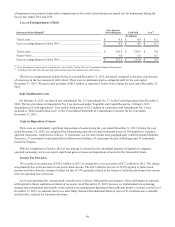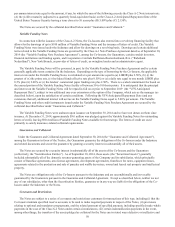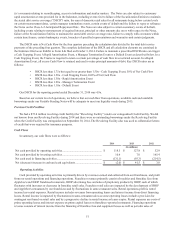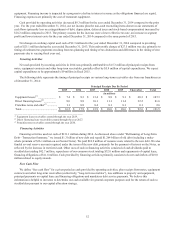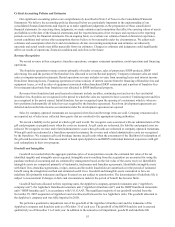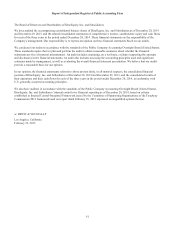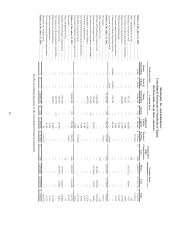IHOP 2014 Annual Report Download - page 75
Download and view the complete annual report
Please find page 75 of the 2014 IHOP annual report below. You can navigate through the pages in the report by either clicking on the pages listed below, or by using the keyword search tool below to find specific information within the annual report.56
intangible assets are evaluated more frequently if we believe indicators of impairment exist. Such indicators include, but are not
limited to, events or circumstances such as a significant adverse change in the business climate, unanticipated competition, a
loss of key personnel, adverse legal or regulatory developments or a significant decline in the market price of our common
stock.
In the process of our annual quantitative test of goodwill, we primarily use the income approach method of valuation that
includes the discounted cash flow method as well as other generally accepted valuation methodologies to determine the fair
value of goodwill and intangible assets. Significant assumptions used to determine fair value under the discounted cash flows
model include future trends in sales, operating expenses, overhead expenses, depreciation, capital expenditures and changes in
working capital, along with an appropriate discount rate based on our estimated cost of equity capital and after-tax cost of debt.
The first step of the quantitative impairment test compares the fair value of each of our reporting units to their carrying value. If
the fair value is in excess of the carrying value, no impairment exists. If the first step does indicate an impairment, a second
step must take place. Under the second step, the fair value of the assets and liabilities of the reporting unit are estimated as if
the reporting unit were acquired in a business combination. The excess of the fair value of the reporting unit over the amounts
assigned to its assets and liabilities is the implied fair value of the goodwill, to which the carrying value of the goodwill must
be adjusted. The fair value of all reporting units is then compared to the current market value of our common stock to
determine if the fair values estimated in the impairment testing process are reasonable in light of the current market value.
In the process of our annual impairment review of the tradename, the most significant indefinite life intangible asset, we
primarily use the relief of royalty method under income approach method of valuation. Significant assumptions used to
determine fair value under the relief of royalty method include future trends in sales, a royalty rate and a discount rate to be
applied to the forecast revenue stream.
Long-Lived Assets
We assess long-lived and intangible assets with finite lives for impairment when events or changes in circumstances
indicate that the carrying value of the assets may not be recoverable. We test impairment using historical cash flows and other
relevant facts and circumstances as the primary basis for our estimates of future cash flows. We consider factors such as the
number of years the restaurant has been operated by us, sales trends, cash flow trends, remaining lease life, and other factors
which apply on a case-by-case basis. The analysis is performed at the individual restaurant level for indicators of permanent
impairment. Recoverability of the restaurant's assets is measured by comparing the assets' carrying value to the undiscounted
cash flows expected to be generated over the assets' remaining useful life or remaining lease term, whichever is less. If the total
expected undiscounted future cash flows are less than the carrying amount of the assets, the carrying amount is written down to
the estimated fair value, and a loss resulting from impairment is recognized by a charge to earnings. This process requires the
use of estimates and assumptions, which are subject to a high degree of judgment. If these assumptions change in the future, we
may be required to record impairment charges for these assets.
Allowance for Credit Losses
The allowance for doubtful accounts is our best estimate of the amount of probable credit losses in our existing
receivables; however, changes in circumstances relating to receivables may result in additional allowances in the future. We
determine the allowance based on historical experience, current payment patterns, future obligations and our assessment of the
ability to pay outstanding balances. The primary indicator of credit quality is delinquency, which is considered to be a
receivable balance greater than 90 days past due. We continually review our allowance for doubtful accounts. Past due balances
and future obligations are reviewed individually for collectability. Account balances are charged against the allowance after all
collection efforts have been exhausted and the potential for recovery is considered remote.
Leases
Our restaurants are located on (i) sites owned by us, (ii) sites leased by us from third parties and (iii) sites owned or leased
by franchisees. For sites owned by or leased by us from third parties, we, in turn, sublease to our franchisees. At the inception
of the lease, each property is evaluated to determine whether the lease will be accounted for as an operating or capital lease in
accordance with the provisions of U.S. GAAP governing the accounting for leases.
The lease term used for straight-line rent expense is calculated from the date we obtain possession of the leased premises
through the lease termination date. We record rent from the possession date through restaurant open date as expense. Once a
restaurant opens for business, we record straight-line rent over the lease term plus contingent rent to the extent it exceeded the
minimum rent obligation per the lease agreement. We use a consistent lease term when calculating depreciation of leasehold
improvements, when determining straight-line rent expense and when determining classification of its leases as either operating
or capital. For leases that contain rent escalations, we record the total rent payable during the lease term, as determined above,
on the straight-line basis over the term of the lease (including the rent holiday period beginning upon our possession of the
premises), and record the difference between the minimum rents paid and the straight-line rent as a lease obligation. Certain




